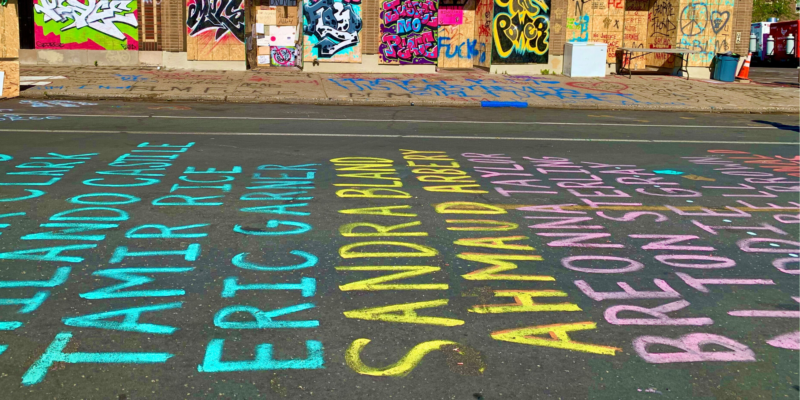In our world, the world of Lacanian psychoanalysis, we sometimes talk about the decline in the power or the impact of the symbolic order as a defining characteristic of our time, and the corollary rise of the importance of the imaginary and the real. This notion echoes others —Lyotard’s observations of the decline of the grand narratives; or, the decline of universality (in the name of particularity or even singularity, in Jameson’s description of postmodernity, for example); or, the general idea of a decline in the power of ideals in the political or social realm (replaced by a society of “decadence,” according to Ross Douthat’s analysis, from the opposite end of the ideological spectrum).
This decline of ideals or attachment to master signifiers was a feature of Lacan’s own approach to looking at the social phenomena of the 1960’s, most notably towards the student protests of that era, which he articulated in his seminar published as The Other Side of Psychoanalysis. In that seminar, and in the appendix of the seminar—a transcript of an encounter that Lacan had with students in 1969—Lacan notes a decline in the protesting youths’ sense of ideals into a certain type of mode of enjoyment. For further elaboration on this and what was happening at the time in France, see also the chapters by Éric Laurent and Jacques-Alain Miller in Jacques Lacan and the Other Side of Psychoanalysis: Reflections on Seminar XVII.
Now, Lacan, while clearly a product of the Old World, was able to see what was going to develop in the future in what was happening in his present, at this key transitional moment in global history. Some of his observations of that moment —in 1969-1970— were remarkably prescient: the rise of the hold of enjoyment (what we would commonly speak of as contemporary consumerism); the rise of enjoyment as a spectacle (e.g., reality shows, celebrity culture, even presidential politics in the United States); the power of technology to libidinally connect with people as articulated in his theory of the lathouses in Seminar XVII (a theory of smartphones before they were even invented); and, a decline in the role of the affect of shame (evident personally and socially and even politically).
But, what about today? In the United States, and now even globally, we are in the midst of a new series of protests that have developed most immediately in response to the killing of George Floyd. While the killing of George Floyd was not an isolated event, but one in a long series of acts of violence and killing of black men by the police in the United States, this one ignited a protest response of a scope that the United States has not seen in fifty years.
Now, while a large social movement like this is diverse and complex (and included some small elements of anarchist actions and looting—understandable in the face of the high unemployment and poverty levels in the country), the most remarkable thing about them is the three signifiers at the focal point of the protests—Black Lives Matter. These are relatively new signifiers, crafted as a hashtag on social media, #BlackLivesMatter, in 2013 as part of a social media response to the acquittal of the man who shot the African-American teen Trayvon Martin in Florida in 2012.[1] These signifiers serve as the point of unification for the very diverse group of Americans—many young people, people of all races—who have come together in a social movement identified with these signifiers, which we also find all over the internet and on posters placed in the windows of homes and businesses across the United States.
What is interesting is that this is not a symbolic identification in the name of some historical ideal, such as a notion of civil rights, which defined the civil rights protests of the 1960s. This is a novel signifier and a new creation—the invention of a signifier that has immense effects (or, to translate this into later Lacanian terminology—this is the creation of a new semblant, which has had effects in the real itself).
And, furthermore, we see a very interesting return of the affect of shame today, which Lacan identified in the 1960s as on the wane. For one of the strengths of the Black Lives Matter protest movement is the way in which the protestors have the function of incarnating the Other itself, as it were, and shaming the country, especially white America, into confronting its implication in the continued racism present today, long after the end of slavery and the end of Jim Crow laws. Indeed, Ibram X. Kendi’s How To Be an Antiracist is now a bestselling book in the United States, and Kendi’s core hypothesis—an assertion we might even format in Greimassian terms, that the ‘contradictory’ point to racism (non-racism) is closed, not available; one can either adopt positions or ideas that are racist or the ‘contrary’ position, anti-racism—is a remarkable text that forces the reader to confront their position regarding racism, something happening in social movements like the protests, in conversations across the country, and in organized institutional activities on university campuses and businesses.
So, in contrast to frequent observations that youth, a driving force in the protests in the United States, are disengaged from society and politics, we see just the opposite. Youth are in fact very engaged, in a movement that has already started to have some real impact in the political and social and economic realms. And, furthermore, these protests, in distinction to what Lacan observed of the French protests of the late 1960s, are protests not organized around enjoyment, but rather signifiers, new signifiers and not old ones, that speak to a symbolic ideal that has allowed people to come together and transcend their identities in the name of this cause.
[1] See https://en.wikipedia.org/wiki/Black_Lives_Matter [accessed on July 7, 2020].
Image @Jéan Béller

